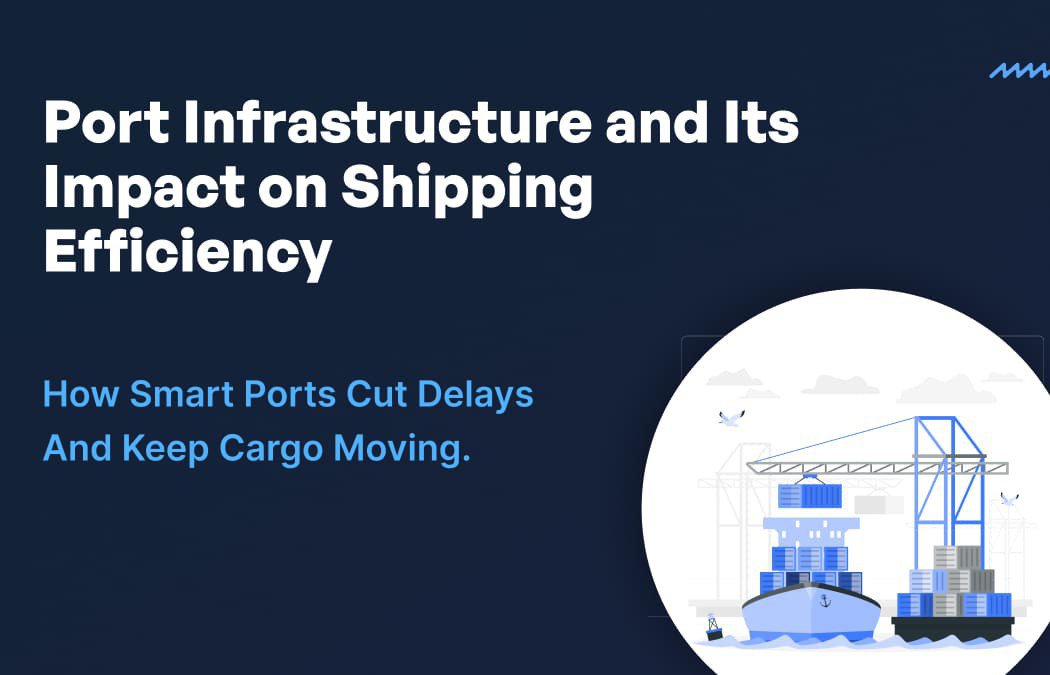
In international shipping, speed and efficiency are everything. One of the most critical factors that keeps cargo moving swiftly across the globe is port infrastructure. From the size and design of terminals to the technology used for cargo handling, a port’s physical setup directly affects how quickly ships can unload, reload, and get back on the water. In this blog, we’ll explore how strong infrastructure boosts port performance, with a close look at the world-class facilities of the Port of Shanghai and the Port of Los Angeles. We’ll also explain why infrastructure is becoming a key competitive edge in global trade.
The Role of Infrastructure in Modern Port Operations
Ports are no longer just places where ships dock and goods are loaded or unloaded manually. Today’s ports are complex logistics ecosystems. Infrastructure plays a vital role in:
Handling large volumes of cargo efficiently
- Reducing vessel waiting times and turnaround delays
- Ensuring smooth intermodal transfer (ship-to-truck, ship-to-rail)
- Improving safety and accuracy of cargo handling
- Accommodating the increasing size of modern vessels
Key infrastructure elements include:
- Deep-water berths to accommodate large vessels
- Wide turning basins and navigation channels
- High-capacity cranes and container handling equipment
- Automated terminals and tracking systems
- On-dock rail and road connections
- Warehousing and inland connectivity
When all these elements are in place and work together, ports can handle cargo faster, avoid congestion, and keep the supply chain moving without unnecessary delays.
Advanced Facilities at Port of Shanghai and Port of Los Angeles
Port of Shanghai (China)
As the busiest container port in the world, the Port of Shanghai is a leader in port innovation and capacity. It handles more than 47 million TEUs (Twenty-foot Equivalent Units) annually and continues to grow.
Key infrastructure highlights:
- Yangshan Deep Water Port: Built on offshore islands, it allows year-round operations even in rough seas.
- Fully automated terminals: Operated by AI and robotics, enabling faster, round-the-clock container movement with minimal human error.
- Smart port technology: Uses sensors, 5G, and digital platforms to monitor cargo flow, reduce downtime, and forecast container traffic.
- Efficient hinterland connections: Strong rail and highway links into mainland China’s industrial zones.
- Result: Ultra-fast cargo movement, efficient customs processing, and reduced ship dwell times.
Port of Los Angeles (USA)
Known as America’s largest and busiest port, the Port of Los Angeles is a vital gateway for goods flowing between Asia and North America.
Key infrastructure highlights:
- Extensive on-dock rail: Enables containers to be transferred directly from ship to train, reducing truck congestion.
- Modern terminals: Equipped with high-speed gantry cranes, large container yards, and energy-efficient equipment.
- Port Optimizer -digital platform: A collaborative data system that gives real-time visibility of cargo status and terminal operations.
- Environmental upgrades: Shore power stations and clean-truck programs reduce emissions while keeping productivity high.
- Result: Faster cargo processing, smoother intermodal transport, and better coordination among shipping lines, terminal operators, and truckers.
How Infrastructure Enhances Turnaround Time and Reduces Delays
When a ship enters a port, the clock is ticking. Delays can be expensive for everyone involved—from the shipping lines to the cargo owners. Here’s how infrastructure helps avoid bottlenecks:
Faster Vessel Berthing and Handling
Deep channels and well-planned docking layouts reduce waiting time for ships to enter and berth. Large cranes and automated terminals allow quick offloading and loading of containers.
Quick Intermodal Transfers
Efficient rail and road connectivity ensures cargo doesn’t sit idle. Ports like Los Angeles use on-dock rail to shift containers straight to trains, minimizing truck traffic and wait time.
Smart Scheduling Systems
Digital platforms at modern ports allow better planning of when trucks arrive, which containers to prioritize, and how to avoid crowding.
Reliable Customs and Security
Infrastructure that supports fast customs scanning and documentation flow (like digital clearance lanes and smart scanners) reduces paperwork delays.
Scalability and Flexibility
Well-designed ports can scale their operations during high-demand seasons, ensuring they don’t get overwhelmed during trade peaks like holiday shipping periods.
Together, these systems reduce average port stay times from days to mere hours in the best-case scenarios—boosting global shipping efficiency overall.
Infrastructure as a Competitive Advantage in Global Trade
With global trade becoming more time-sensitive and competitive, ports that offer faster, more reliable service are naturally more attractive to shipping lines and cargo owners. Strong infrastructure offers the following competitive benefits:
- Cost Savings: Reduced dwell time and demurrage fees translate into lower overall logistics costs.
- Customer Trust: Importers and exporters are more likely to use ports that deliver consistency and speed.
- Attracting Larger Ships: Only ports with deep berths and strong infrastructure can host mega-ships, unlocking economies of scale.
- Resilience Against Disruption: Ports with modern infrastructure are better equipped to handle crises—whether it’s a weather event, cyber threat, or global shipping backlog.
- Environmental Compliance: Many governments and companies now prefer ports with green infrastructure—like electric cranes or low-emission handling equipment—to meet ESG goals.
Ports like Shanghai and Los Angeles are great examples of how investing in modern infrastructure creates long-term gains for the port, shipping companies, and global trade as a whole.
Final Thoughts
Port infrastructure is no longer just about size—it’s about smart design, speed, and seamless connectivity. As global trade continues to grow and evolve, the efficiency of a port can either support or slow down supply chains. Ports like Shanghai and Los Angeles show what’s possible when technology, planning, and investment come together.
For businesses and importers, choosing ports with strong infrastructure means fewer delays, lower costs, and a more reliable delivery process. As shipping demands increase and evolve, port infrastructure will remain a defining factor in who leads and who lags behind in global logistics.





 Get instant quote
and compare offers in real time
Get instant quote
and compare offers in real time